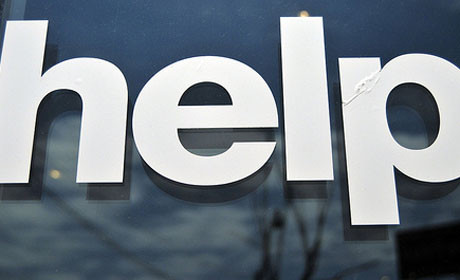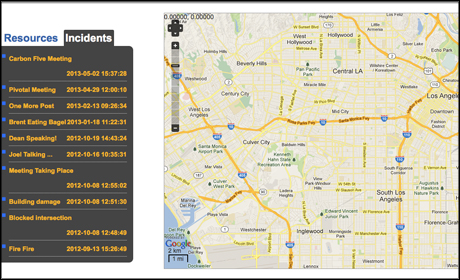
When a crisis hits a community, people need information fast. Those in the area affected need to know key details, as do friends and family, the emergency services and the press.
Many people take to social media to share information in breaking news situations, and where a level of danger remains there is often the need to gain a quick understanding of who is at risk.
In response to this, the Innovation Lab team at the University of Southern California (USC) Annenberg, has been building Crisis Connection, an app linked up to a public online map, which works to provide a resource for people to report moments of crisis, and connect with others who may be able to help. The project was granted $600,000 from the LA-focused Ahmanson Foundation in October 2012.
The idea is that by engaging with the platform, members of the public can use the information to "make important decisions about their own safety", such as certain roads to avoid during a crisis.
The data is then plotted on the map, also providing a useful resource for the media, not only to see where stories are breaking, but make more informed decisions about where to distribute reporting resources.

A screengrab of the web prototype
The power of the community
Gabriel Kahn, a professor at USC, told Journalism.co.uk about his experience in a former role as bureau chief for the Wall Street Journal in Los Angeles, when he knew an earthquake could strike at any moment.
"I knew there was going to be one eventually and it was going to be big and disruptive and it was going to be a massive, massive story.
"And I had 12 reporters in the bureau, which is a lot of reporters, especially these days, but I still just wasn't confident that we were going to be able to cover the story adequately by just spreading our reporting resources around like that."
But further down the line he said he "realised I didn't need more reporters". Instead, the answer could have been to look to the community to "share information that was going on, to help us figure out what the story was".
When Crisis Connection is launched, those who find themselves in a crisis will be able to post updates or images, for example, to give an idea of what they are experiencing, which is then pinpointed on a map.
For the press, these reports can help not only flag up a possible news event, but also give some idea of the scale of it.
"If you get 1,000, 2,000 or however many posts in a short time period, you can start to understand, looking at the map, how damage is concentrated, what the different issues are in different places," Kahn said, "and you can start to piece together an understanding of the situation".
As well as posting information on the crisis, the app will also offer "a resource-brokering application", Kahn added, in which users can "post a need or you can post a situation", which someone else who could help can then respond to.
"You could say 'my car has fallen into a drainage ditch', or something like that, and someone else could say 'hey I have a Jeep with a winch', and they can attach their resource to your need on the map.
"So what we're trying to do is create a more efficient connection between need and resource."
He stressed, however, that this is in no way "trying to replace 911". "This is not a substitute for that," he said.
The potential for news outlets
As well as the benefits for the general public, Crisis Connection can also help news outlets in "delivering accurate, essential information in a timely fashion", by having access to the resource of information being shared publicly on the map linked to the app.
It is then up to the news outlet to "verify these individual reports and corroborate them", Kahn added.
Kahn added that said certain users, such as a member of the emergency services or someone who has previously used the app and shared authentic information, could potentially have a "higher credit score", than an unknown user, to help with gauging the reliability of information.
"That's the kind of thing we're working with," he said.
The platform is designed to cope in crisis situations where mobile communications can sometimes come under pressure. In response to this, Crisis Connection will offer "people-finder functionality" to let users contact other via email, Twitter or Facebook with a map of where they are. This could also help journalists let their newsdesks know their location.This information is popping up all over the place on social networks but not in any one kind of dedicated platform that's really designed to handle that kind of informationGabriel Kahn, USC
Another feature of the platform which could prove valuable for journalists when rolled out to the public is the ability to apply geographical areas of interest, which for a journalist could be a specific patch, or the areas in which businesses or organisations they report on are based, for example. Then, when something new happens in that area, the journalist will receive an alert rather than having to regularly monitor a map.
Currently, when news breaks, citizens and journalists alike often turn to social media platforms for the latest updates and eye-witness accounts, but these tend to be loud and busy places, not just focused on crisis events.
"This information is popping up all over the place on social networks but not in any one kind of dedicated platform that's really designed to handle that kind of information," Kahn said.
The challenges
But while the noise of social media presents Crisis Connection with an opportunity to offer a focused space for this important information, it also puts a spotlight on one of the key challenges, as Kahn explains.The advantage of a dedicated platform is of course that people go there for specifically this type of action, so you separate the signal from the noise as a result of thatGabriel Kahn, USC
"If we create another platform, do people feel compelled to actually create a new profile, on a new platform, which involves a new app, or is this all just going to be happening over Twitter, or something like that?"
Kahn added that he does not "have a great answer for that one yet".
"Should we just try to do this in a way that's integrated with existing social media platforms, or should it be a dedicated platform? The advantage of a dedicated platform is of course that people go there for specifically this type of action, so you separate the signal from the noise as a result of that. And people go there with a particular mindset: I either need this kind of information or I want to contribute this information in a useful way."
But ensuring engagement during a crisis could be difficult if users are not already familiar with the platform, another challenge for Crisis Connection. A way to tackle this is being addressed by the launch approach. Later this year Crisis Connection will go live, but will only be shared among the community at USC. Additionally, the app's features will be applied in everyday situations to try and build people's awareness of the tool.
"One of the big issues is what's going to motivate someone to contribute information?" Kahn said. "How are we going to make this compelling, how are we going to create a user interface and a product and everything else that's going to make people actually want to share this information?"How are we going to make this compelling, how are we going to create a user interface and a product and everything else that's going to make people actually want to share this information?Gabriel Kahn, USC
Partly, the idea is that by distributing the app among the university community, users may be "a little bit more compelled to share details if they feel that they're sharing it with a community of people that they know".
Another way in which the app will try to encourage engagement is through push notifications, which can also be used in non-threatening situations to encourage participation.
Correction: The spelling of Gabriel's surname has been corrected from Khan to Kahn.
Free daily newsletter
If you like our news and feature articles, you can sign up to receive our free daily (Mon-Fri) email newsletter (mobile friendly).
Related articles
- 38 mojo apps from BBC trainer Marc Blank-Settle
- The FT launches Digital Edition App, a print newspaper replica
- Headlines Network releases guide for covering traumatic breaking news
- How Reuters Connect evolved its model in response to covid-19 and Ukraine
- How do you manage a breaking news team from home?









